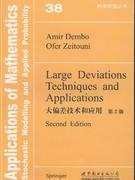-
>
宇宙、量子和人类心灵
-
>
(精)BBC地球故事系列-星际旅行
-
>
从一到无穷大
-
>
图说相对论(32开平装)
-
>
一本有趣又有料的化学书
-
>
刘薰宇的数学三书:原来数学可以这样学全3册
-
>
光学零件制造工艺学
大偏差技术和应用(第2版) 版权信息
- ISBN:750628291
- 条形码:9787506282918 ; 978-7-5062-8291-8
- 装帧:一般胶版纸
- 册数:暂无
- 重量:暂无
- 所属分类:>>
大偏差技术和应用(第2版) 本书特色
本书是“科学前沿丛书”之《大偏差技术和应用(第2版)》,该书分7个章节,从个例到一般,从有限维到无限维,全面、系统地介绍了大偏差理论的背景,思想和技巧以及大量的应用。该书可供各大专院校作为教材使用,也可供从事相关工作的人员作为参考用书使用。
大偏差技术和应用(第2版) 内容简介
本书由浅入深,从个例到一般,从有限维到无限维,系统地介绍了大偏差理论的背景,思想和技巧以及大量的应用。书中内容翔实,思想清晰,处理,严谨流畅,相当多的理论或为作者原创,或者作者从原创论文中摘出并加以处理。 本书是研究生、博士生学习大偏差理论的一本标准教材,也是研究人员的一本标准参考书。
大偏差技术和应用(第2版) 目录
大偏差技术和应用(第2版) 节选
eface to the Second
Edition
?his edition does not involve any major reorganization of the basic plan
.f the book; however, there are still a substantial number of changes. The
aaccuracies and typos that were pointed out, or detected by us, and that
vere previously posted on our web site, have been corrected. Here and
here, clarifying remarks have been added. Some new exercises have been
dded, often to reflect a ressult we consider interesting that did not find its
vay into the main body of the text. Some exercises have been dropped,
ither because the new presentation covers them, or because they were too
1ifficult or unclear. The general principles of Chapter 4 have been updated
y the addition of Theorem 4.4.13 and Lemmas 4.1.23, 4.1.24, and 4.6.5.
More substantial changes have also been incorporated in the text.
1. A new section on concentration inequalities (Section 2.4) has been
added. It overviews techniques, ranging from martingale methods
to Talagrand's inequalities, to obtain upper bound on exponentially
negligible events.
2. A new section dealing with a metric framework for large deviations
(Section 4.7) has been added.
3. A new section explaining the basic ingredients of a weak convergence
approach to large deviations (Section 6.6) has been added. This sec-
tion largely follows the recent text of Dupuis and Ellis, and provides
yet another approach to the proof of Sanov's theorem.
4. A new subsection with refinements of the Gibbs conditioning principle
(Section 7.3.3) has been added.
5. Section 7.2 dealing with sampling without replacement has been com-
pletely rewritten. This is a much stronger version of the results, which
viii PREFACE TO THE SECOND EDITION
also provides an alternative proof of Mogulskii's theorem. This ad-
vance was possible by introducing an appropriate coupling.
The added material preserves the numbering of the first edition. In par-
ticular, theorems, lemmas and definitions in the first edition have retained
the same numbers, although some exercises may now be labeled differently.
Another change concerns the bibliography: The historical notes have
been rewritten with more than 100 entries added to the bibliography, both
to rectify some omissions in the first edition and to reflect some advances
that have been made since then. As in the first edition, no claim is being
made for completeness.
The web site http://www-ee.technion.ac.il/~ zeitouni/cor.ps will contain
corrections, additions, etc. related to this edition. Readers are strongly
encouraged to send ns their corrections or suggestions.
We thank Tiefeng Jiang for a preprint of [Jia95], on which Section 4.7
is based. The help of Alex de Acosta, Peter Eichelsbacher, Ioannis Kon-
toyiannis, Stephen Turner, and Tim Zajic in suggesting improvements to
this edition is gratefully acknowledged. We conclude this preface by thank-
ing our editor, John Kimmel, and his staff at Springer for their help in
producing this edition.
STANFORD, CALIFORNIA&n
- >
名家带你读鲁迅:朝花夕拾
名家带你读鲁迅:朝花夕拾
¥14.3¥21.0 - >
【精装绘本】画给孩子的中国神话
【精装绘本】画给孩子的中国神话
¥20.9¥55.0 - >
月亮虎
月亮虎
¥15.4¥48.0 - >
罗曼·罗兰读书随笔-精装
罗曼·罗兰读书随笔-精装
¥40.6¥58.0 - >
新文学天穹两巨星--鲁迅与胡适/红烛学术丛书(红烛学术丛书)
新文学天穹两巨星--鲁迅与胡适/红烛学术丛书(红烛学术丛书)
¥9.9¥23.0 - >
月亮与六便士
月亮与六便士
¥13.4¥42.0 - >
莉莉和章鱼
莉莉和章鱼
¥16.0¥42.0 - >
朝闻道
朝闻道
¥20.2¥23.8
-
随机过程基础及其应用
¥9.5¥28 -
概率论与数理统计
¥4.2¥12 -
2022图书×抽奖盲袋
¥9.9¥25 -
2023读书月阅读盲盒——天黑,闭眼,刀谁?
¥42.3¥158 -
2022读者节纪念徽章-三星会员专属
¥45¥45.6



















